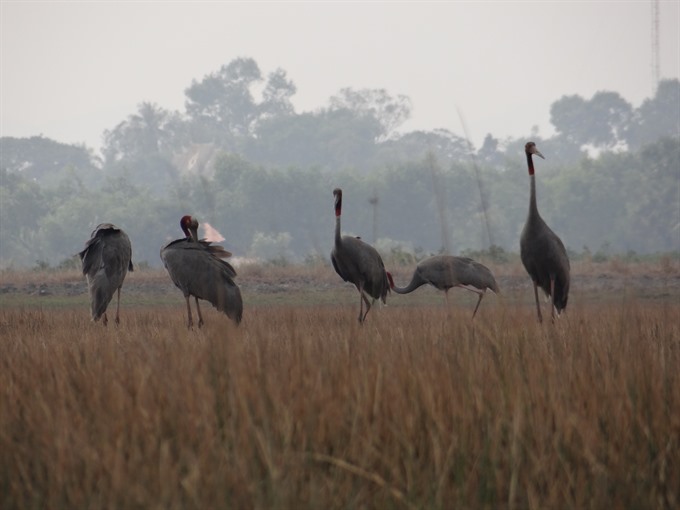 |
| Giant bird: The Sarus crane, which is 5.8 to 6 feet tall, is the tallest flying bird in the world. VNS Photo Van Chau |
Viet Nam News
In the last few years, more Sarus cranes, a threatened species, have been spotted returning to the wetlands in Kien Giang Province. The restoration of the wetlands, the last extensive remnant of a lepironia grass ecosystem in the Mekong River Delta, has been ongoing for decades. The Phu My Conservation project, begun in 2006, has played a major part in preserving the local habitat for Sarus cranes, and has helped locals earn a living by making handicrafts from lepironia. Van Chau reports.
In the late 80s, conservation efforts by foreign and local groups helped restore the wild grasses and wetlands in Viet Nam that were once a habitat for the Sarus crane, the largest flying bird in the world that is now on the threatened species list.
Years of war had decimated the wetlands in southwestern Viet Nam, which were home to the cranes, considered a sacred symbol in the country because of their lifelong loyalty to their partners and longevity.
Over the years, conservation projects, many of them carried out by the International Crane Foundation (ICF) and local scientists, have helped safeguard small remnant wetlands that cranes could use.
Despite the appearance of more cranes last year and earlier this year, the wetlands area in Phu My Commune in the coastal southern province of Kien Giang remains somewhat under threat, mostly now due to climate change.
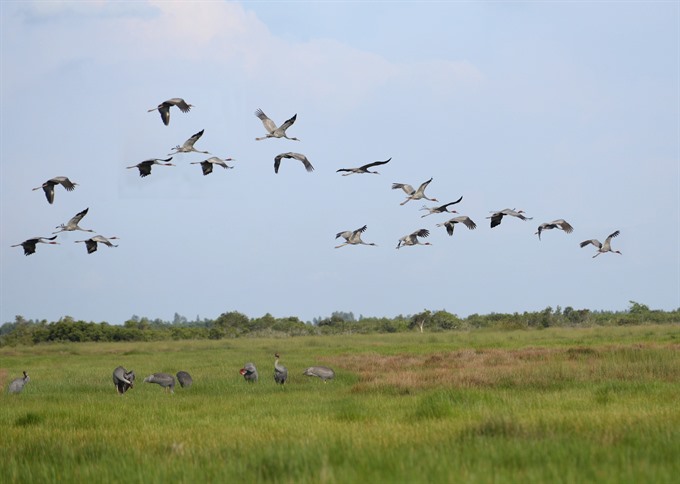 |
| Fraidy cranes: Sarus cranes fly away if they hear noise. Visitors have to stand about 100 metres away and watch them with binoculars. VNS Photo Van Chau |
In the past, the main threats were habitat loss and degradation of food resources caused by human activities, including illegal conversion of wetlands, changes in agricultural practices, and poisoning from agricultural and industrial chemicals.
The trade of eggs, chicks and adults of Sarus cranes and the hunting of eggs and adults for food were also a threat.
One of the most successful efforts in maintaining the wetlands habitat over the years has been the Phu My Conservation project, begun in 2006 in Kien Giang’s melaleuca forests.
The Phu My sanctuary, which contains co bang (Lepironia articulata), a grass-like perennial plant favoured by the Sarus cranes, is located in Kien Luong District which borders Cambodia.
Last year, and more recently, in March and April, many cranes were spotted at the Phu My Sanctuary, an unexpected surprise for locals and scientists.
“At the end of April, my officers saw more than 100 Sarus cranes in the Phu My Conservation area, looking for shrimp, their favourite food,” Lam Hong Tuan, deputy director of the Phu My Conservation project, said.
“The cranes are very smart and fly away if they hear noise. So, you have to watch them from afar, maybe more than 100 metres away with binoculars.”
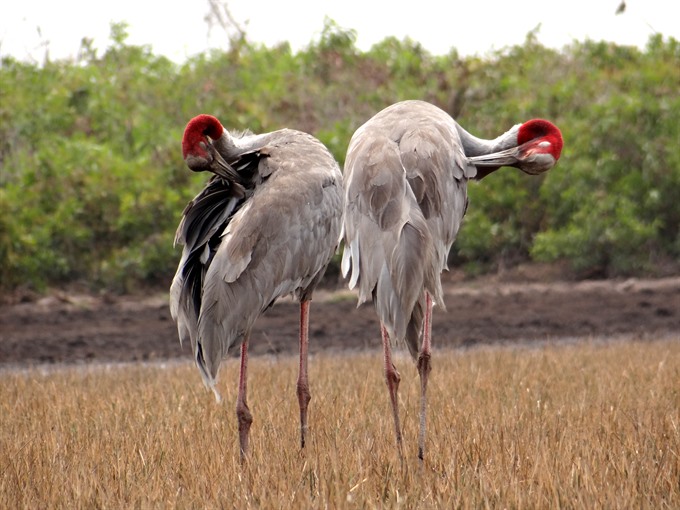 |
| One true love: In the wild, Sarus cranes often mate for life and stay in one place. It is said that when a crane dies, its partner will never mate with another crane. VNS Photo Van Chau |
The village of Phu My is among the poorest in Viet Nam, according to Tuan. The adjacent 5,000-acre wetland area supports the last extensive remnant of lepironia grass ecosystem in the Mekong Delta.
“The wetland is important for biodiversity, and provides the major economic base for the community’s Khmer ethnic minority, as villagers harvest grass to produce woven goods,” he said.
This year, researchers from the Centre for Biodiversity and Development in Kien Luong District also noticed that more cranes were visiting Phu My, around 120 one morning in March and 77 the next day.
At the crack of dawn, when mist covered the wet fields, a flock of cranes suddenly landed, Tuan said.
“A researcher for the centre said it was amazing to watch the cranes spread their wings and stretch out their long legs to land like aeroplanes. From February to April, the dry season, is the best chance to see them,” he said. "But you have to be prepared to walk or even crawl quietly if you want to have a chance of seeing them."
In 2006, the Phu My Conservation project won a natural environmental protection award from UN-HABITAT, and was a finalist for the 2007 Equator Prize sponsored by the United Nations Development Programme (UNDP).
Tran Triet, director of the International Crane Foundation’s (ICF) Southeast Asia Programme, a biology professor at HCM City National University, told Viet Nam News that it had taken many years to seek foreign sponsors and persuade provincial authorities to supply land for the project.
"Thousands of dollars were invested to preserve the wetlands and protect the feeding habitats of the cranes, and if that had not been done, it would have all been lost," he said.
In 2009, six local households dug canals, invading the proposed nature reserve to make way for shrimp breeding ponds. This took away water and grasses from the fields.
But the International Union for Conservation of Nature (IUCN) and local authorities intervened and the locals filled up the canals, according to Triet.
Handicrafts
Aside from serving as a habitat for the cranes, the Phu My Conservation area helps local residents earn a living from growing lepironia grass and making handicrafts.
The Phu My project, which preserves 2,000ha of wetlands, has trained the ethnic Khmer locals in making high-quality handbags, hats and baskets from lepironia grass harvested in the area, contributing to sustainable development of the wetlands.
Local residents have also received assistance in marketing and selling their goods to tourists in HCM City and higher-value export markets.
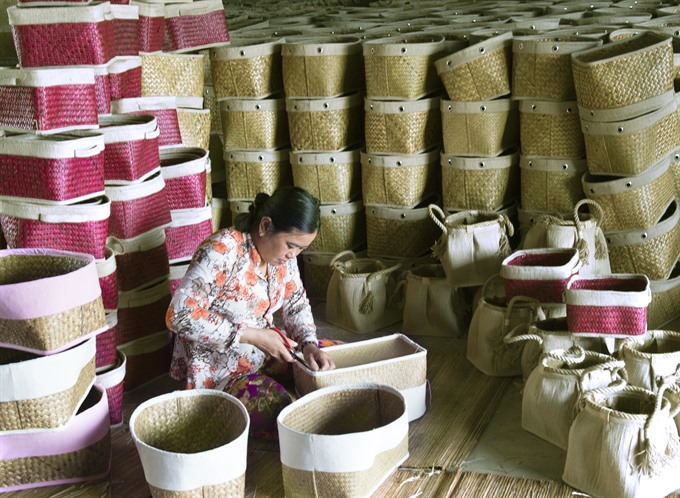 |
| Up and up: Local residents have received assistance in marketing and selling their goods to tourists in HCM City and higher-value export markets. VNS Photo Van Chau |
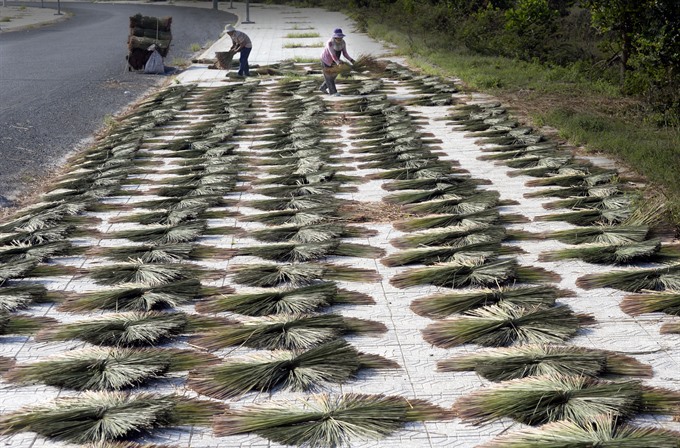 |
| Specialty: Ethnic Khmer locals dry the co bang (Lepironia articulata) in Phu My Commune, Kien Giang Province’s Kien Luong District. VNS Photo Van Chau |
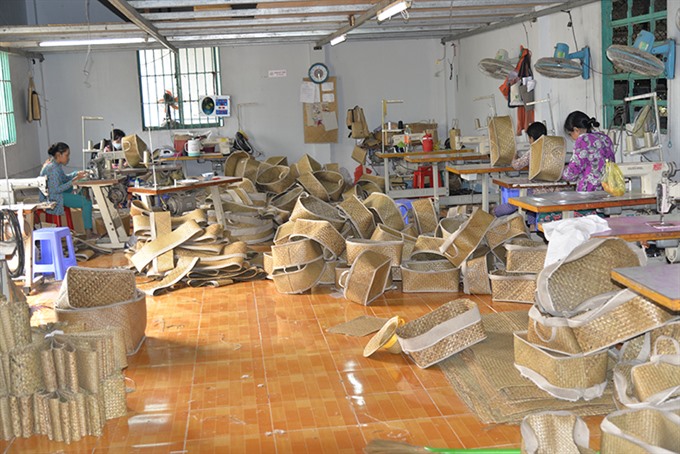 |
| New riches: Two hundred people currently live on handicraft products with a monthly income of VND5 million (US$230) to VND7 million (US$300), three times their previous income. VNS Photo Van Chau |
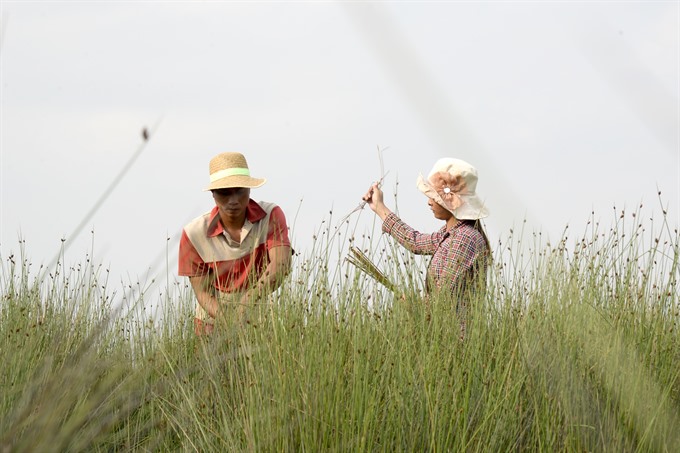 |
| Packing it up: The local Khmer residents harvest the co bang (Lepironia articulata) in Phu My Commune, Kien Giang Province’s Kien Luong District. VNS Photo Van Chau |
Over the years, the Phu My project has seen positive results in wildlife monitoring, control of invasive alien species, and sustainable harvest of lepironia.
“The grass grows in an area that acts as a shelter and feeding habitat for Sarus cranes,” Triet of ICF said. "This was perhaps the first project in Viet Nam that combined nature conservation, poverty alleviation, and cultural preservation.”
Nguyen Van Ho, a wetlands resident, whose mission is to collect information for the local authority, said the project had trained 150 people and now employs 32 full-time workers.
Of 350 households in the area, 200 currently live on handicraft products with a monthly income of VND5 million (US$230) to VND7 million (US$300), three times their previous income.
Thach Tha, a resident in the Phu My Conservation area, said in the early months of the dry season, when the water level falls in the Mekong Delta, masses of Eleocharis dulcis (whose tuber is food for the cranes) appear in large spaces in the melaleuca forest.
“At that time, the cranes often return to hunt for this food. In the wild, they often mate for life and stay in one place. It’s said that when a crane dies, its partner will never mate with another crane. Some will even starve themselves to death,” Tha added.
The beautifully feathered cranes can be seen performing delightful dances when hunting, trying to attract female cranes, or clearing their feathers.
Their diet is varied. They are omnivorous and can eat coarse food in swamps and shallow waters such as roots, bulbs, insects, crustaceans and some small animals.
However, shrimp and the tubers of Eleocharis dulcis, a perennial grass-like herb with roots in muddy soil under water, are their favourite foods.
Characteristics
The Sarus crane can reach a height of 1.8 metres. Its body is grey while the head and neck is red, a contrast which makes them easy to recognise from a distance.
The breeding season for the Sarus crane is usually in the rainy season in northern Cambodia. The birds pick up branches of trees, canes and dried grasses to make sturdy nests in cane-brakes in the wetlands, carefully protected from enemies.
Each season, the mother cranes lay one or two eggs, incubated by the mother or father cranes for 27 to 35 days. Even when they are able to fly (within 50-65 days), they do not separate from their parents in the first year.
With help from their parents, they gradually practise their skills to find food and travel to wild lands in Dong Thap (in Tram Chim National Park, the only other area in Viet Nam where Sarus cranes appear) and Kien Giang.
Although it is not technically a migratory bird, Sarus cranes often take long trips to seek food and water, especially during the dry season. They often sleep in shallow waters to avoid danger from predators.
Nguyen Van Hung, 43, an amateur photographer who has been taking photos of the cranes in Phu My for 15 years, said he was fortunate to be in the right place at the right time to see the birds “strut their stuff as they stretch their wings or dart to the right and left in grass fields to look for food or fly into the sky.”
Another amateur photographer, Le Vu, 52, from Kien Giang, said he was worried about the cranes’ survival.
“This year, poor farmers in Phu My Commune secretly planted rice seeds on the Eleocharis dulcis fields. However, the rice fields dried out because of lack of rain," he said. "In the past, when rice was planted in the wetlands, the birds did not return. So, the policy now is to let the wild grass Eleocharis naturally grow, and more flocks of cranes are expected to return."
“We who live in the area can listen to their piercing bird songs in the early morning, see them spread their silver wings, and watch loving couples dance and small families look for food under the guard of bigger birds. But we wonder: how many people will be fortunate to admire this wild natural beauty? Will this beautiful scenery last?” VNS
OVietnam